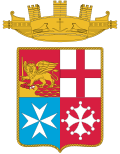Design and description
The Maestrale-class destroyers were a completely new design intended to rectify the stability problems of the preceding Folgore class. [1] They had a length between perpendiculars of 101.6 meters (333 ft 4 in) and an overall length of 106.7 meters (350 ft 1 in). The ships had a beam of 10.15 meters (33 ft 4 in) and a mean draft of 3.31 meters (10 ft 10 in) [2] and 4.3 meters (14 ft 1 in) at deep load. [1] They displaced 1,640 metric tons (1,610 long tons ) at normal load, and 2,243 metric tons (2,208 long tons) at deep load. [3] Their complement during wartime was 190 officers and enlisted men. [4]
The Maestrales were powered by two Parsons geared steam turbines, each driving one propeller shaft using steam supplied by a trio of three-drum boilers. [4] The turbines were designed to produce 44,000 shaft horsepower (33,000 kW ) and a speed of 32–33 knots (59–61 km/h; 37–38 mph) in service, although they reached speeds of 38–39 knots (70–72 km/h; 44–45 mph) during their sea trials while lightly loaded. The ships carried enough fuel oil to give them a range of 2,600–2,800 nautical miles (4,800–5,200 km; 3,000–3,200 mi) at a speed of 18 knots (33 km/h; 21 mph) and 690 nmi (1,280 km; 790 mi) at a speed of 33 knots (61 km/h; 38 mph). [1]
Their main battery consisted of four 50-caliber 120-millimeter (4.7 in) guns in two twin-gun turrets, one each fore and aft of the superstructure. [3] Amidships were a pair of 15-caliber 120-millimeter star shell guns. Anti-aircraft (AA) defense for the Maestrale-class ships was provided by four 13.2-millimeter (0.52 in) machine guns. They were equipped with six 533-millimeter (21 in) torpedo tubes in two triple mounts amidships. Although the ships were not provided with a sonar system for anti-submarine work, they were fitted with a pair of depth charge throwers. [1] The Maestrales could carry 56 mines. [3]
This page is based on this
Wikipedia article Text is available under the
CC BY-SA 4.0 license; additional terms may apply.
Images, videos and audio are available under their respective licenses.

